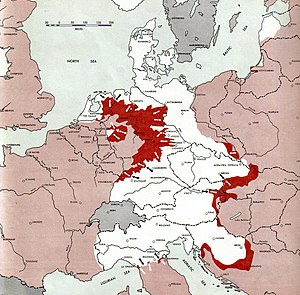Syrmian Front
| Syrmian Front | |||||||
|---|---|---|---|---|---|---|---|
| Part of World War II in Yugoslavia | |||||||
 Syrmian frontline (far south-east) as a part of the European Eastern Front in April 1945. |
|||||||
|
|||||||
| Belligerents | |||||||
|
Allies: (including |
Axis: |
||||||
| Commanders and leaders | |||||||
|
|
|
||||||
| Casualties and losses | |||||||
|
(including |
Total 30,000 killed | ||||||
The Syrmian Front (Serbo-Croatian: Srijemski front, Сремски фронт) was an Axis line of defense during World War II. It was established as part of the Eastern Front in late October 1944 in Syrmia and east Slavonia, northwest of Belgrade.
After the Yugoslav Partisans and the Red Army expelled the Germans from Belgrade in the Belgrade Offensive, the retreating Wehrmacht and the Croatian Armed Forces used fortifications to protect the withdrawal of German Army Group E from the Balkans. With help from their Soviet allies, the Partisans (by then recognized as the Yugoslav army), joined by Bulgarian and Italian forces, fought a difficult winter campaign and finally broke through the front on 12 April 1945.
After the Syrmian front was broken, occupied Yugoslavia was liberated.
After the September advance through Romania and Bulgaria in October 1944, The Red Army, together with Yugoslav forces, took Belgrade (central communication node of the Balkans) in the Belgrade Offensive. Due to Yugoslav partisan activity, the Yugoslav-Allied Operation Ratweek, and pressure from the Bulgarian Army, the Germans failed to prevent this while they awaited the redeployment of Army Group E troops from Greece. The Red Army decided to exploit this delay and continued to advance with the 3rd Ukrainian Front from Belgrade to south-west Hungary. The aim of the advance was to separate and protect their main attack in Hungary from attacks on the flank by Army Group E from the south.
...
Wikipedia
